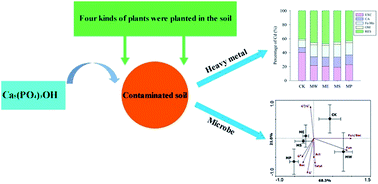Immobilization of copper and cadmium by hydroxyapatite combined with phytoextraction and changes in microbial community structure in a smelter-impacted soil
Abstract
Applying hydroxyapatite to immobilize heavy metals may cause a decline in soil quality, whereas phytoextraction has been shown to be a slow process under normal agronomic conditions. The benefits of combining hydroxyapatite application and phytoextraction are unclear for improving the soil ecosystem at the same time as remediating heavy metals. A three-year field experiment was conducted to test the combined effects of hydroxyapatite application and phytoextraction (Sedum plumbizincicola, Elsholtzia splendens, and Pennisetum sp.) on remediating cadmium (Cd) and copper (Cu) and improving the soil microbial community structure in a smelter-impacted site. Total Cd and Cu were fractionated using a sequential extraction procedure. Soil microbial biomass and community composition were measured by phospholipid-derived fatty acid (PLFA) analysis. The results showed that hydroxyapatite addition (1%) increased soil pH and decreased the exchangeable fraction of Cu and Cd compared with the control. Combining with hydroxyapatite application, the growth of phytoextractors increased organic matter content and decreased total Cu and Cd concentrations in the soil. Hydroxyapatite application disturbed the soil microbial PLFA composition by increasing fungal PLFA, whereas a combination with plant growth reduced the trend of soil fungal growth. Combining hydroxyapatite with Pennisetum sp. particularly improved Gram-negative and Gram-positive bacterial biomass and reduced the ratio of fungi to bacteria. In conclusion, combining hydroxyapatite with suitable phytoextractors is a promising approach for remediating heavy metals (e.g., Cu and Cd) and simultaneously improving soil microbial community structure and the ecological environment in contaminated areas.



 Please wait while we load your content...
Please wait while we load your content...